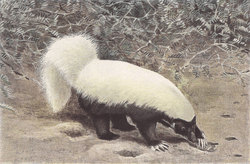Hog-nosed skunk
| Hog-nosed skunk | |
|---|---|
 | |
| An illustration of a hog-nosed skunk by Louis Agassiz Fuertes. | |
| Scientific classification | |
| Kingdom: | Animalia |
| Phylum: | Chordata |
| Class: | Mammalia |
| Order: | Carnivora |
| Family: | Mephitidae |
| Genus: | Conepatus Gray, 1837 |
| Species | |
 | |
| Conepatus ranges | |
The hog-nosed skunks belong to the genus Conepatus and are members of the family Mephitidae (skunks). They are native to the Americas. They have white backs and tails and black underparts.[1]
Species
- Conepatus chinga - Molina's hog-nosed skunk
- Conepatus humboldtii - Humboldt's hog-nosed skunk
- Conepatus leuconotus - American hog-nosed skunk
- Conepatus semistriatus - striped hog-nosed skunk
Recent work has concluded that the western hog-nosed skunk or common hog-nosed skunk (formerly Conepatus mesoleucus) is the same species as the American hog-nosed skunk, and that Conepatus leuconotus is the correct name of the merged populations.[2][3]
Description
.jpg)
The individual hog-nosed skunk species vary in size, but among them is included the largest of all skunks. All are characterized by comparatively short hair, especially on the tail, and this appendage lacks the plumelike appearance observed in other skunks. The nose is prolonged into a distinct "snout", naked on the top and sides and evidently used for rooting in the earth after the manner of a pig. In addition, the front feet are armed with long, heavy claws. The claws are well developed for digging up insect prey.[4] and the front legs and shoulders are provided with a strong muscular development for digging, as in a badger. This likeness has led to the use in some places of the appropriate name "badger skunk" for these animals. The extent of the stripe on the hind of the skunk, and the color of the tail underside suggests a distinction between eastern and western species. The eastern species is a narrow stripe, with black under the base of the tail. The western distinction is a wide stripe, with a predominantly white tail. The hair on these skunks is coarse and harsh, lacking the qualities which render the coats of their northern relatives so valuable. They are nocturnal.[4]
Before the merge of the American hog-nosed skunks, the eastern hog-nosed skunk, Conepatus leuconotus is typically larger than the western hog-nosed skunk, Conepatus mesoleucus. Female eastern hog-nosed skunks range from 58–74 cm in length and 19–34 cm in height. They weigh between 2.0-4.0 kg. Male hog-nosed skunks range from 56–92 cm in length and 22–41 cm in height. They weigh on average between 3.0-4.5 kg. The western hog-nosed skunk ranged from 40–84 cm in length, 13–35 cm in height, and 1.1-2.7 kg. Males are larger than females and can occasionally reach 4.5 kg.[4] The teeth are smaller in C. mesoleucus than in C. leuconotus.[5]
Range
The eastern hog-nosed skunk is found only in Southern Texas, Veracruz, Mexico, and Arizona[4][5] The Molina hog-nosed skunk, also known as Andes skunk, (C. chinga) is found in Argentina, Bolivia, Brazil, Chile, Peru, and Uruguay.[6] Humboldt's hog-nosed skunk, also known as Patagonian hog-nosed skunk (C. humboldtii) finds its habitat in the open grassy areas in the Patagonian regions of Chile and Argentina.[7] The western hog-nosed skunk (C. mesoleucus) is found in Colorado, Southern Washington, Texas, Arizona, Sierra Guadalupe Cohuila, New Mexico, Chicago, Colima, Honduras, Sonora, and Nicaragua.[5] The striped hog-nosed skunk, C. semistriatus is found in Veracruz, Costa Rica, and Guatemala.[5]
Habitat
Where their range coincides with that of the common skunks, the local distribution of the two is practically the same. They live along the bottom-lands of watercourses, where vegetation is abundant and the supply of food most plentiful, or in canyons and on rocky mountain slopes.
For their protection hog-nosed skunks create their own burrows, generally within a bank, or beneath a rock, or the roots of a tree, but do not hesitate to take possession of the deserted burrows of other animals, or of natural cavities among the rocks. Owing to their strictly nocturnal habits, they are generally much less frequently seen than the common skunks, even in localities where they are numerous. Sightings are recorded from brush habitat and semiopen grasslands. Habitats may also include rocky terrain and stream beds in desert-scrub and mesquite grassland.
Infrequent sightings of the American hog-nosed skunks raise concerns over the conservation status.[4]
Feeding habits
Although both the spotted skunk and common skunks live mainly on insects, the hog-nosed skunks are even more insectivorous in their feeding habits. The bare snout appears to be used constantly for the purpose of rooting out beetles, grubs, and larvae of various kinds from the ground.
References
- ↑ Skunk. Columbia Electronic Encyclopedia, 6Th Edition [serial online]. October 2011;:1. Available from: Academic Search Premier, Ipswich, MA. Accessed November 29, 2011.
- ↑ Western Hog-nosed Skunk
- ↑ Cuarón AD & Helgen H (2008). "Conepatus leuconotus". IUCN Red List of Threatened Species. Version 2008. International Union for Conservation of Nature. Retrieved 2008-10-24.
- 1 2 3 4 5 Kays, Roland (2002). Mammals of North America. Princeton, New Jersey: Princeton University Press. pp. 180–182. ISBN 0-691-07012-1.
- 1 2 3 4 Hall, Raymond (1981). The Mammals of North America Volume II. Canada: Wiley-Interscience Publication. pp. 1025–1028. ISBN 0-471-05444-5.
- ↑ Emmons, L. & Helgen, K. (2008). Conepatus chinga. In: IUCN 2008. IUCN Red List of Threatened Species. Downloaded on 29 November 2010.
- ↑ Zapata, Sonia C.; Travaini, Alejandro; Martínez-Peck, Rolando (2001). "Seasonal feeding habits of the Patagonian hog-nosed skunk Conepatus humboldtii in southern Patagonia". Acta Theriologica. 46: 97–102.
External links
| Wikispecies has information related to: Conepatus |
| Wikimedia Commons has media related to Conepatus. |
This article incorporates text from the publication Wild Animals of North America, copyright 1918 by the National Geographic Society. This book is in the public domain.